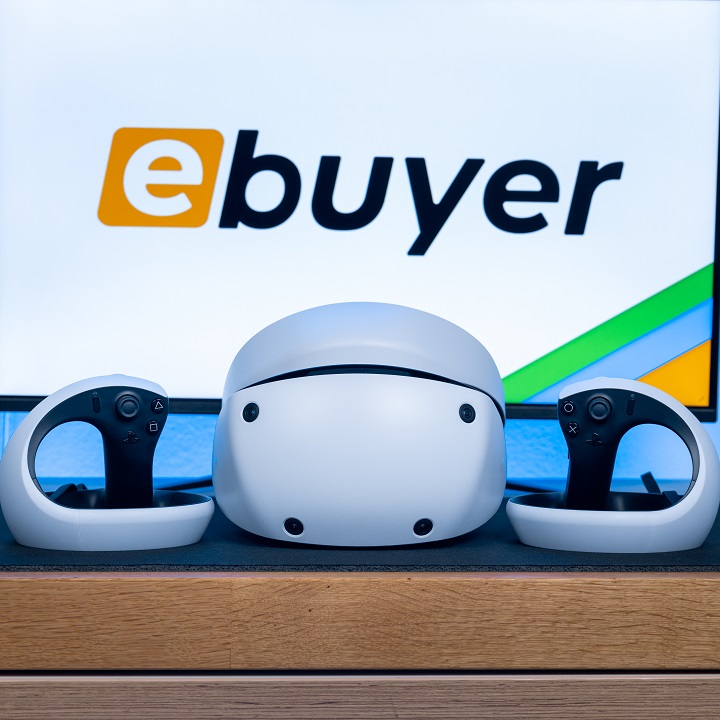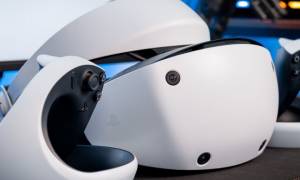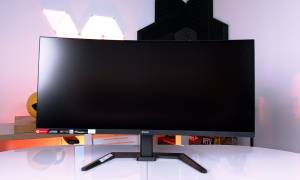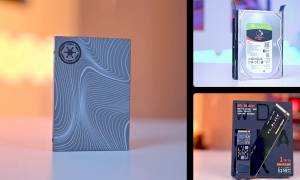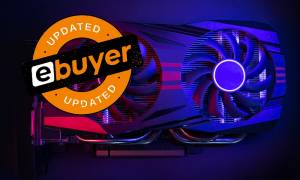Get ready to experience the next generation of virtual reality with PlayStation VR2, featuring HDR OLED displays, intelligent eye-tracking, new Sense controllers, and more.
PS VR2 launched earlier this year, but it was only available through Sony’s limited online store – many people didn’t even know it had released! Now, you can pick up PlayStation VR2 from all the big retailers, including Ebuyer.
We’ve already unboxed PlayStation VR2 over on the Ebuyer YouTube channel, so let’s walk through the tech-specs of the new virtual reality headset and see how they stack up against the competition.
Design & comfort
If you’ve ever tried PlayStation VR1, PlayStation VR2’s design is very similar. The new virtual reality headset uses the same halo-style headband as the original. We’re quite fond of this design as it distributes the headset’s weight more evenly than an over-the-head strap, making it feel less like there’s a bulky display assembly hanging off your face. Interestingly, the PlayStation VR2 headset itself has built-in haptic feedback. It’s not quite to the same accuracy or detail as the PlayStation 5’s DualSense controller, but it does help add to the immersion level.
Taking the headset on and off is easy enough. There’s a button on the back of the headband to release it and a dial to tighten it. At the top of the headset is a scope adjustment button to slide the headset back and forth for the perfect fit. Depending on how close you bring the headset in, PlayStation VR2 has approximately a 110° field of view – 10° wider than PS VR1 – and we found that there’s enough adjustability to comfortably wear it with glasses. PlayStation VR2 also features physical IPD adjustment, controlled with a dial on top of the headset. This allows you to move the lenses inside the headset and align them perfectly with your eyes for maximum sharpness. You can eyeball it, but PlayStation VR2’s set-up process will guide you through the adjustment.
While PlayStation VR2 includes a pair of earphones – the headband even has earphone holders – you can just use your own wired headphones with the 3.5mm audio jack. It’s worth noting that rubber light shield is detachable, so it’ll be easy to replace it and keep the headset clean. Finally, at the bottom of the headset is its power button and a built-in microphone.
Inside-out tracking

PlayStation VR1 relied on an external camera mounted in front of your television to track the headset and controllers’ position in 3-D space, and it felt like a very finicky and cobbled together solution. This time around, Sony has opted for a more reliable inside-out tracking system. No external camera is required for PlayStation VR2, everything’s done on the headset itself.
In total, there are four cameras embedded directly into the headset. These are used to scan your environment to generate a playable space for room-scale experiences and to track the controllers’ position. You can also hit a button on the bottom of the headset to enable pass-through mode. In this mode, you can see through these cameras with proper 3-D and depth correction, meaning you won’t’ have to constantly take the headset off just to find its controllers.
Inside-out tracking isn’t a perfect solution, mind you, as these cameras are positioned toward the front of the headset. When you reach behind the headset – to draw an arrow in Horizon: Call of the Mountain, for example – the cameras won’t be able to track the controllers. In these instances, the controllers’ gyroscopes and accelerometers enable some degree of tracking, but it can get jittery and inaccurate.
A robust, multi-camera outside-in tracking system is certainly better for those room-scale experiences, but that requires a decent amount of space and set up. Comparatively, you don’t need to screw a bunch of base stations into your walls with PlayStation VR2, it’s very much plug-and-play.
Single cable
Setting up PlayStation VR2 is incredibly easy. Unlike PlayStation VR1, which required several cables and a dedicated break-out box to connect to the console, PlayStation VR2 instead uses a single USB-C cord. Hook this cord up to the PlayStation 5’s front USB-C port and you’re good to go. Measuring at 4.5m, it’s long enough for seated, standing, and room-scale experiences.
OLED HDR Displays

Sony has gone all-in with PlayStation VR2’s displays, and it’s paid off massively. Firstly, these displays have a resolution of 2,000 x 2,040 per-eye. That’s four times the pixel count per-eye of PlayStation VR1, noticeably reducing the screen-door effect – where you can see the blank space in-between the displays’ pixels – and increasing clarity.
What’s more, they’re OLED and HDR – a winning combination for a virtual reality headset. OLED gives you low persistence blur and those deep, inky black levels, while the super-high peak brightness of HDR makes the white of an image stunningly bright. Cruising down Tokyo Expressway at night-time in Gran Turismo 7, with cars’ headlights in your rear view, completely sold us on OLED HDR. The LCDs displays of other headsets look dull in comparison, with black levels that are more of a dark-grey.
These displays are clocked at a refresh rate of 120Hz for super-smooth gameplay too, though whether a game’s frame rate can match this high refresh rate is another story. Resident Evil 8 and Gran Turismo 7, two hardware-intensive AAA titles, max out at 60 frames-per-second with asynchronous time-warp on PlayStation VR2. Displaying 60Hz content on 120Hz panels like this can cause a blurred, double-image effect, which is annoying given how great the panel themselves are. If only Sony made PlayStation VR2 compatible with PC in an official capacity.
Eye tracking

One of the biggest features separating PlayStation VR2 from other virtual reality headsets is eye-tracking. At least for now, PlayStation VR2 is one of the few consumer-grade headsets on the market to support this technology – and it’s a game-changer. Inside the PlayStation VR2 headset, somewhere by the displays, is a small IR camera that can detect where you’re looking.
When working in conjunction with foveated rendering, eye-tracking greatly improves the performance and image quality of PlayStation VR2. Foveated rendering increases a game’s rendering resolution where the user is directly looking and decreases it in their (already blurry) peripheral vision, saving system resources. In turn, games can target a higher visual fidelity and/or frame rate.
AAA titles like Horizon: Call of the Mountain, Resident Evil 8, and Gran Turismo 7 look simply stunning and don’t suffer from drastically reduced visual fidelity compared to their flat-screen counterparts. PlayStation VR2’s eye-tracking is so fast that it’s extremely hard to catch a game adjusting its resolution. To the user, games just look high-resolution at all times.
Eye-tracking can also be used for gameplay, effectively turning your eyes into a controller. This can be as simple as selecting menus by just looking at them, but Rez: Infinite’s updated virtual reality mode – which lets you lock onto enemies without touching the controller – shows the tech off the best. It’s a surreal experience to be able to lie back and play a game almost entirely with your eyes.
Sense controllers
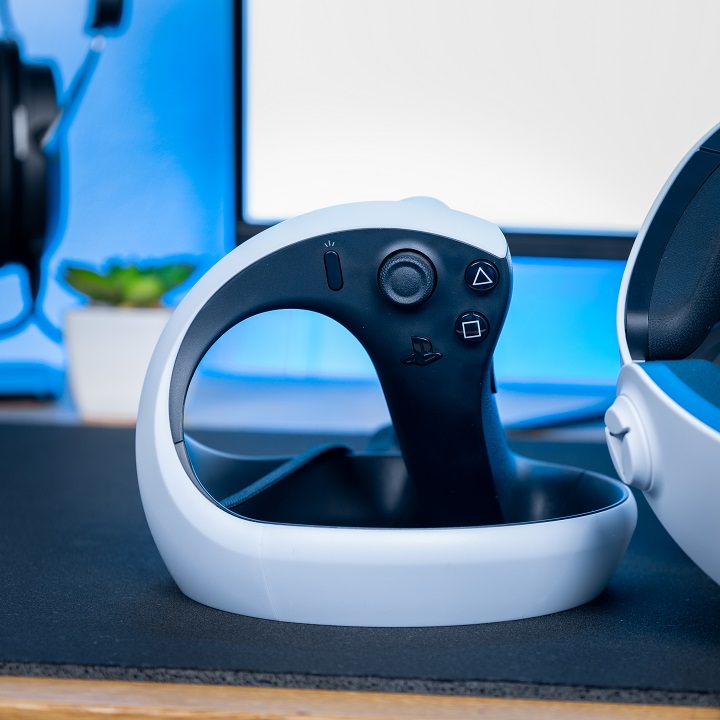
The bundled-in Sense controllers are a huge upgrade over the PlayStation VR1’s Move controllers – which weren’t even designed for virtual reality in the first place! With a ring of hidden IR LEDs, these Sense controllers are most comparable in design to Oculus’s Touch controllers. Its buttons are also equipped with capacitive touch sensors for thumb, index, and middle finger detection. It’s not full-on finger tracking like Valve’s Index controllers, but finger detection still allows for basic gestures, such as pointing or grabbing an object.
Otherwise, the button layout is largely the same as an ordinary PlayStation controller, except that it’s split over two independent controllers. L1/R1 have been moved to the controllers’ grips and there’s no d-pad, but that’s it. These controllers even feature the haptic feedback and adaptive triggers of PlayStation 5’s DualSense controller, making virtual reality experience feel all that more tactile, tangible, and immersive.
PlayStation VR2 at Ebuyer
All in all, we’re seriously impressed with PlayStation VR2. It being exclusive to PlayStation 5 limits its library and games – no Half-Life: Alyx, for example – and the performance of what games it does have, but the hardware itself is top notch across the board. Its HDR OLED displays set the standard for virtual reality headsets going forward, while its eye-tracking enables some truly innovative experiences. No doubt we’ll see more gaming-focused virtual reality headsets in the future that implement these features. But as of now, PlayStation VR2 is one of the best money can buy – even beating out the much more expensive Valve Index in many ways.
Pick up a PlayStation VR2 headset or a PS VR2 bundle for yourself over at Ebuyer.

